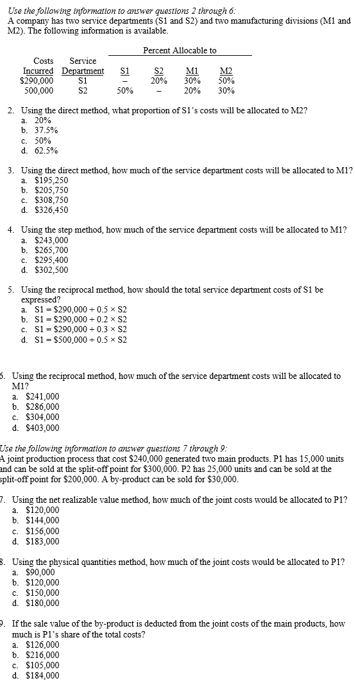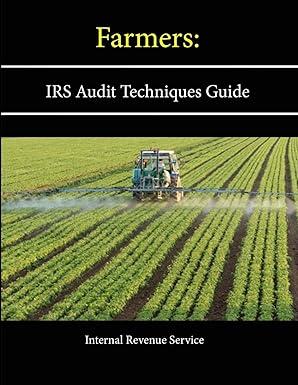
Use the following information to answer questions 2 throwgh 6 : A company has two service departments ( $1 and $2 ) and two manufacturing divisions (M1 and M2 ). The following information is available. 2. Using the direct method, what proportion of SI's costs will be allocated to M2? a. 20% b. 37.5% c. 50% d. 62.5% 3. Using the direct method, how much of the service department costs will be allocated to M1? a. $195,250 b. $205,750 c. $308,750 d. $326,450 4. Using the step method, how much of the service department costs will be allocated to M1? a. $243,000 b. $265,700 c. $295,400 d. $302,300 5. Using the reciprocal method, how should the total service department costs of $1 be expressed? a. S1=$290,000+0.5S2 b. S1=$290,000+0.2S2 c. SI=$290,000+0.3S2 d. $1=$500,000+0.5$2 5. Using the reciprocal method, how much of the service department costs will be allocated to M1? a. $241,000 b. $286,000 c. $304,000 d. $403,000 Use the following information to answer questions 7 throwgh 9 : A joint production process that cost $240,000 generated two main products. P1 has 15,000 units and ean be sold at the split-off point for $300,000. P2 has 25,000 units and can be sold at the iplit-off point for $200,000. A by-product ean be sold for $30,000. 7. Using the net realizable value method, how much of the joint costs would be allocated to P1? a. $120,000 b. $144,000 c. $156,000 d. $183,000 8. Using the physical quantities method, how much of the joint costs would be allocated to P1? a. $90,000 b. $120,000 c. $150,000 d. $180,000 If the sale value of the by-product is deducted from the joint costs of the main products, bow much is PI's share of the total costs? a. $126,000 b. $216,000 c. $105,000 d. $184,000 Use the following information to answer questions 2 throwgh 6 : A company has two service departments ( $1 and $2 ) and two manufacturing divisions (M1 and M2 ). The following information is available. 2. Using the direct method, what proportion of SI's costs will be allocated to M2? a. 20% b. 37.5% c. 50% d. 62.5% 3. Using the direct method, how much of the service department costs will be allocated to M1? a. $195,250 b. $205,750 c. $308,750 d. $326,450 4. Using the step method, how much of the service department costs will be allocated to M1? a. $243,000 b. $265,700 c. $295,400 d. $302,300 5. Using the reciprocal method, how should the total service department costs of $1 be expressed? a. S1=$290,000+0.5S2 b. S1=$290,000+0.2S2 c. SI=$290,000+0.3S2 d. $1=$500,000+0.5$2 5. Using the reciprocal method, how much of the service department costs will be allocated to M1? a. $241,000 b. $286,000 c. $304,000 d. $403,000 Use the following information to answer questions 7 throwgh 9 : A joint production process that cost $240,000 generated two main products. P1 has 15,000 units and ean be sold at the split-off point for $300,000. P2 has 25,000 units and can be sold at the iplit-off point for $200,000. A by-product ean be sold for $30,000. 7. Using the net realizable value method, how much of the joint costs would be allocated to P1? a. $120,000 b. $144,000 c. $156,000 d. $183,000 8. Using the physical quantities method, how much of the joint costs would be allocated to P1? a. $90,000 b. $120,000 c. $150,000 d. $180,000 If the sale value of the by-product is deducted from the joint costs of the main products, bow much is PI's share of the total costs? a. $126,000 b. $216,000 c. $105,000 d. $184,000







